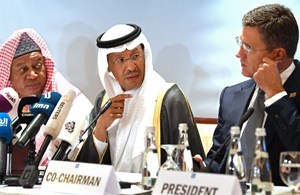OPEC+ narrowing in on deal to restore oil production gradually
(Bloomberg) --OPEC+ is closing in on a deal to gently ease output curbs after days of fractious negotiations that revealed deep cracks at the core of the cartel.
After direct talks, Russia and Saudi Arabia have thrashed out a plan to take to other members, according to one delegate. Others also said a deal was close, but the details remain unclear. Discussions have focused on a gradual relaxation of output cuts over several months, and according to one delegate there could be a one-month delay before the tapering starts.
The proposals, if accepted by all of the Organization of Petroleum Exporting Countries and its allies, would tweak the current agreement -- struck during the depths of the pandemic in April -- that allows 1.9 million barrels a day of additional crude back on the market from Jan. 1. It’s not clear yet whether the proposals would return that same volume of production over a longer period, or a different amount.
OPEC has underpinned the recovery in oil prices with its historic cuts this year and the latest round of talks is testing its unity -- and credibility. Negotiations have been unusually tense amid a clash between Saudi Arabia and the United Arab Emirates, and the meeting on Thursday was pushed back by two days because of the deadlock.
“Ministers are inching closer to a compromise that should break the impasse,” Energy Aspects Ltd. co-founder Amrita Sen said in a note. “OPEC+ officials are debating a more limited adjustment to the current deal than the proposed three-month delay.”
Oil in London was down about 0.5% at 10:51 a.m local time, trading near $48.
Russian Position
Importantly, the deal is likely to keep the oil market in deficit throughout the first quarter, allowing OPEC to drain bloated inventories. If the group had gone ahead with the full 1.9 million barrels a day increase on Jan. 1, the group’s economists calculated that the market would have flipped into surplus.
A gentler tapering of the cuts could offer a potential compromise after days of talks, offering something to members that are concerned about the fragility of the market amid a second wave of the virus, and also to nations that are impatient to raise production. The Russian government, after internal talks with its own oil companies, is ready to agree to a gradual easing of supply curbs within the first quarter of 2021, said a person familiar with the discussions.
OPEC+ rescued the oil market this year from an unprecedented slump, slashing production as the pandemic crushed demand. While crude has surged in recent weeks, a new wave of virus infections is hitting the global economy.
Fractious talks earlier this week raised the specter of the deal falling apart, which would sink prices and batter an industry that spans from tiny nations like Gabon to corporate giants such as Exxon Mobil Corp.
The intensity of the fight between Saudi Arabia and the UAE took OPEC-watchers by surprise, as the pair have long been staunch allies. But Abu Dhabi has been pursuing a more independent oil policy and wants to pump more.
Over the summer, Abu Dhabi’s impatience led it to casting aside its usual obedience to cartel discipline, and pump more crude than its quota allowed. The Saudis were furious, and summoned UAE Energy Minister Suhail Al-Mazrouei to Riyadh for a public dressing down.
While the UAE subsequently atoned, people familiar with its oil policy say Abu Dhabi believes the current quota is unfair, and is keen to make the most of massive investments in production capacity. It’s also planning a new regional price benchmark based around its Murban crude variety, which needs the kind of volumes that clash with production limits.
If a deal is eventually crafted, it will be scrutinized for its ability to keep the coalition together and disciplined. Tensions are expected to reemerge next year.



